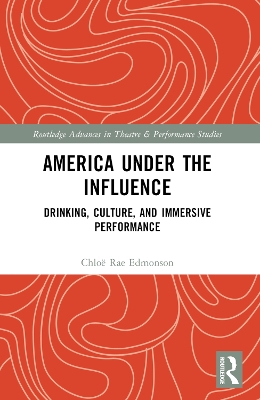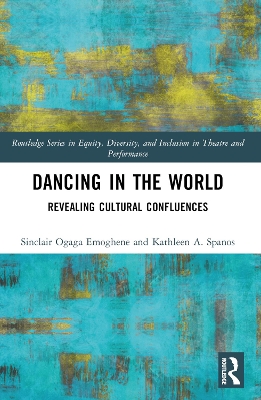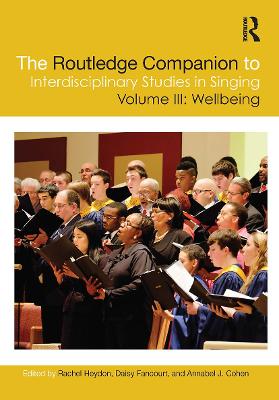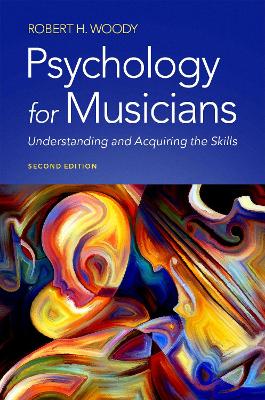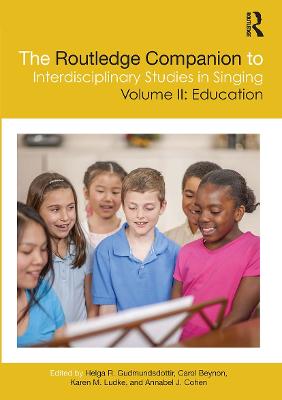Routledge Companion to Interdisciplinary Studies in Singing, Volume I: Development
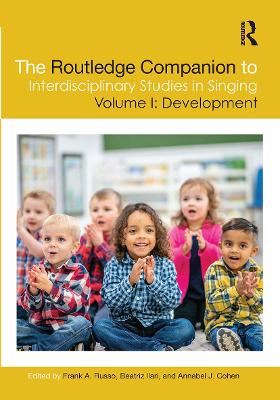 portes grátis
portes grátis
Routledge Companion to Interdisciplinary Studies in Singing, Volume I: Development
Volume I: Development
Cohen, Annabel J.; Ilari, Beatriz; Russo, Frank A.
Taylor & Francis Ltd
02/2022
520
Mole
Inglês
9781032171395
15 a 20 dias
961
Descrição não disponível.
Introduction: Singing, development, interdisciplinarity, and the biopsychosocial framework (Frank A. Russo, Beatriz Ilari and Annabel J. Cohen) / Part I: Musical, historical and scientific foundations of singing development / 1. Historical, musical, and scientific foundations for studies of singing: Introduction to Part I (Beatriz Ilari and Frank A. Russo) / 2. From canonical babbling to early singing and its relation to the beginnings of speech (Stefanie Stadler Elmer) / 3. An evolutionary perspective on the human capacity for singing (Nicholas Bannan) / 4. Salomon Henschen and the Search for a Brain Center for Singing (Amy B. Graziano, Eric C. Born, and Julene K. Johnson) / 5. The mechanics and acoustics of the singing voice: registers, resonances and the source-filter interaction (Joe Wolfe, Maeva Garnier, Nathalie Henrich Bernardoni and John Smith) / 6. Brain mechanisms underlying singing (Annabel J. Cohen, Daniel Levitin, and Boris Kleber) / 7. Singing and speech as comparable phenomena: a dynamical approach (Beatriz Raposo de Medeiros) / 8. Linguistic tone and melody in the singing of sub-Saharan Africa (Thomas M. Pooley) / 9. The effects on hormones and age on the voice (Jennifer P. Rodney and Robert T. Sataloff) / 10. An empirical evaluation of note segmentation of automatic pitch-extraction methods for the singing voice (Johanna Devaney) / 11. Annotating multimodal data of singing and speaking (Coralie Vincent) / Part II: The relation between the perception and production of singing / 12. Perception, vocal production and the development of singing: Introduction to Part II (Beatriz Ilari) / 13. The role and functions of infant-directed singing in early development (Simone Falk and Christine D. Tsang) / 14. Home musical environment and singing development in infancy (Eugenia Costa-Giomi and Lucia Bennett) / 15. An Exploration of the Relationships Between Perception, Production, Cognition and Environment in the Development of Singing in Children (Christine D. Tsang and Laurel J. Trainor) / 16. Vocal Communication in Birds and Humans - Beyond Song and Speech (Leslie S. Phillmore and Christine D. Tsang) / 17. Singing and the child who is deaf: Focusing on the individual (Maria Yennari, Lyn Schraer-Joiner, and Georgiann Toole) / Part III: Multimodal (audio, visual, and motor) aspects of singing development / 18. Multimodal Aspects of Singing Development: Introduction to Part III (Frank A. Russo) / 19. Infant-directed singing from a dynamic multimodal perspective: Evolutionary origins, cross-cultural variation, and relation to infant-directed speech (Sandra E. Trehub and Frank A. Russo) / 20. Before singing: The role of reflexivity during vocal interactions with caregivers in diaper change daily routine (Anna Rita Addessi) / 21. Motor system involvement in the perception of singing (Frank A. Russo) / Part IV: Assessing multiple singing skills / 22. Measuring the development of singing ability and the mental testing tradition: Introduction to Part IV (Annabel J. Cohen) / 23. A meta-analytic perspective on the development of singing in children (Christina L. Svec) / 24. Construction and validation of the Seattle Singing Accuracy Protocol (SSAP): An automated online measure of singing accuracy (Peter Q. Pfordresher and Steven M. Demorest) / 25. Solo or Doubled Singing: Ecological Validity and Effects in Two Response Modes (Bryan E. Nichols) / 26. Correlations among music aptitude, singing voice development, and singing accuracy achievement in young children (Catherine M. Tu, Texas A & M University-Kingsville) / 27. Performance of Canadians on the automated AIRS Test Battery of Singing Skills: music training and age (Annabel J. Cohen, Bing Yi Pan, Eric da Silva, and Kyle Dutton) / 28. Analyzing singing abilities and language skills during the elementary school years (Michael Forrester) / 29. "What is Your Favorite Song?": Musical Preferences and Taste in School-Aged Children Over Five Years (Eun Cho, Assal Habibi and Beatriz Ilari) / 30. How musical culture is reflected in the choice of favorite songs of Estonian children (Marju Raju, Laura Vaelja and Jaan Ross) / 31. Tone-language and musical experience: Pitch accuracy and key choice in the AIRS Test Battery of Singing Skills (ATBSS) (Annabel J. Cohen, Jingyuan Sun, Esther Mang, Bing-Yi Pan and Lee Fui Lim) / 32. Effects of group vocal training in older adults: Pitch accuracy and vocal improvisation (Jennifer Bugos, Chloe Kantoris, and Joel Pagan) / Conclusion: Interdisciplinary research in singing development: The way forward (Annabel J. Cohen, Beatriz Ilari, and Frank A. Russo)
Este título pertence ao(s) assunto(s) indicados(s). Para ver outros títulos clique no assunto desejado.
Vocal Folds;voice studies;Song Singing;singing;Vice Versa;music therapy;Voice Range Profiles;music education;Mi Fa;singing development;Pop Star;AIRS;multimodality;Music Perception Skill;Part III;Canonical Babbling;Pitch Accuracy;Singing Accuracy;CHILDES Database;Pitch Discrimination;Pitch Matching;Linguistic Tone;Children's Singing;Musical Aptitude;VF;Favorite Song;Pitch Perception;Singing Ability;Children's Songs;Singing Skills;YIN Algorithm
Introduction: Singing, development, interdisciplinarity, and the biopsychosocial framework (Frank A. Russo, Beatriz Ilari and Annabel J. Cohen) / Part I: Musical, historical and scientific foundations of singing development / 1. Historical, musical, and scientific foundations for studies of singing: Introduction to Part I (Beatriz Ilari and Frank A. Russo) / 2. From canonical babbling to early singing and its relation to the beginnings of speech (Stefanie Stadler Elmer) / 3. An evolutionary perspective on the human capacity for singing (Nicholas Bannan) / 4. Salomon Henschen and the Search for a Brain Center for Singing (Amy B. Graziano, Eric C. Born, and Julene K. Johnson) / 5. The mechanics and acoustics of the singing voice: registers, resonances and the source-filter interaction (Joe Wolfe, Maeva Garnier, Nathalie Henrich Bernardoni and John Smith) / 6. Brain mechanisms underlying singing (Annabel J. Cohen, Daniel Levitin, and Boris Kleber) / 7. Singing and speech as comparable phenomena: a dynamical approach (Beatriz Raposo de Medeiros) / 8. Linguistic tone and melody in the singing of sub-Saharan Africa (Thomas M. Pooley) / 9. The effects on hormones and age on the voice (Jennifer P. Rodney and Robert T. Sataloff) / 10. An empirical evaluation of note segmentation of automatic pitch-extraction methods for the singing voice (Johanna Devaney) / 11. Annotating multimodal data of singing and speaking (Coralie Vincent) / Part II: The relation between the perception and production of singing / 12. Perception, vocal production and the development of singing: Introduction to Part II (Beatriz Ilari) / 13. The role and functions of infant-directed singing in early development (Simone Falk and Christine D. Tsang) / 14. Home musical environment and singing development in infancy (Eugenia Costa-Giomi and Lucia Bennett) / 15. An Exploration of the Relationships Between Perception, Production, Cognition and Environment in the Development of Singing in Children (Christine D. Tsang and Laurel J. Trainor) / 16. Vocal Communication in Birds and Humans - Beyond Song and Speech (Leslie S. Phillmore and Christine D. Tsang) / 17. Singing and the child who is deaf: Focusing on the individual (Maria Yennari, Lyn Schraer-Joiner, and Georgiann Toole) / Part III: Multimodal (audio, visual, and motor) aspects of singing development / 18. Multimodal Aspects of Singing Development: Introduction to Part III (Frank A. Russo) / 19. Infant-directed singing from a dynamic multimodal perspective: Evolutionary origins, cross-cultural variation, and relation to infant-directed speech (Sandra E. Trehub and Frank A. Russo) / 20. Before singing: The role of reflexivity during vocal interactions with caregivers in diaper change daily routine (Anna Rita Addessi) / 21. Motor system involvement in the perception of singing (Frank A. Russo) / Part IV: Assessing multiple singing skills / 22. Measuring the development of singing ability and the mental testing tradition: Introduction to Part IV (Annabel J. Cohen) / 23. A meta-analytic perspective on the development of singing in children (Christina L. Svec) / 24. Construction and validation of the Seattle Singing Accuracy Protocol (SSAP): An automated online measure of singing accuracy (Peter Q. Pfordresher and Steven M. Demorest) / 25. Solo or Doubled Singing: Ecological Validity and Effects in Two Response Modes (Bryan E. Nichols) / 26. Correlations among music aptitude, singing voice development, and singing accuracy achievement in young children (Catherine M. Tu, Texas A & M University-Kingsville) / 27. Performance of Canadians on the automated AIRS Test Battery of Singing Skills: music training and age (Annabel J. Cohen, Bing Yi Pan, Eric da Silva, and Kyle Dutton) / 28. Analyzing singing abilities and language skills during the elementary school years (Michael Forrester) / 29. "What is Your Favorite Song?": Musical Preferences and Taste in School-Aged Children Over Five Years (Eun Cho, Assal Habibi and Beatriz Ilari) / 30. How musical culture is reflected in the choice of favorite songs of Estonian children (Marju Raju, Laura Vaelja and Jaan Ross) / 31. Tone-language and musical experience: Pitch accuracy and key choice in the AIRS Test Battery of Singing Skills (ATBSS) (Annabel J. Cohen, Jingyuan Sun, Esther Mang, Bing-Yi Pan and Lee Fui Lim) / 32. Effects of group vocal training in older adults: Pitch accuracy and vocal improvisation (Jennifer Bugos, Chloe Kantoris, and Joel Pagan) / Conclusion: Interdisciplinary research in singing development: The way forward (Annabel J. Cohen, Beatriz Ilari, and Frank A. Russo)
Este título pertence ao(s) assunto(s) indicados(s). Para ver outros títulos clique no assunto desejado.
Vocal Folds;voice studies;Song Singing;singing;Vice Versa;music therapy;Voice Range Profiles;music education;Mi Fa;singing development;Pop Star;AIRS;multimodality;Music Perception Skill;Part III;Canonical Babbling;Pitch Accuracy;Singing Accuracy;CHILDES Database;Pitch Discrimination;Pitch Matching;Linguistic Tone;Children's Singing;Musical Aptitude;VF;Favorite Song;Pitch Perception;Singing Ability;Children's Songs;Singing Skills;YIN Algorithm


